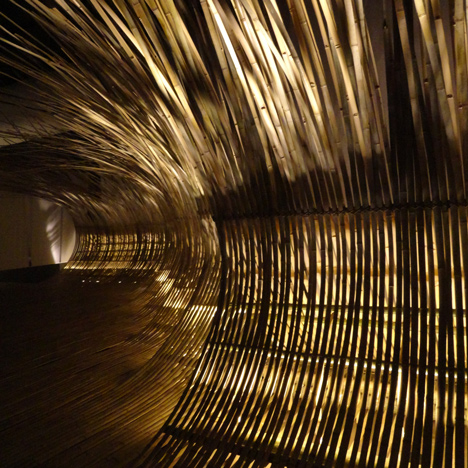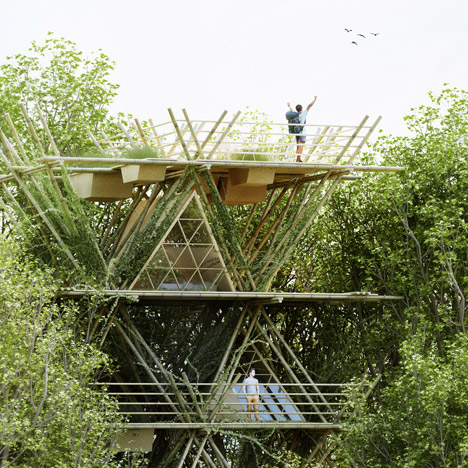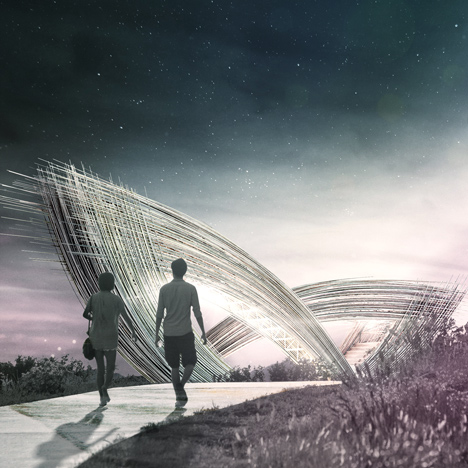Leading architects are "turning the focus back on bamboo"
Bamboo architects: a new movement led by architects Kengo Kuma, Shigeru Ban and Vo Trong Nghia is putting bamboo construction back in the spotlight, according to Chris Precht of Austro-Chinese practice Penda (+ slideshow + interview).
The rise of modern architecture in the last century pushed the material "out of the spotlight", Precht said, but he added that the overuse of glass and steel in contemporary architecture meant that people are now "longing for a certain imperfection in things; an imperfection you get with natural materials."
"When we see a building made of bamboo, we think about the natural environment," added Precht, who recently unveiled a concept for a bamboo hotel and a spectacular bamboo gateway. "That creates a certain campfire romanticism of being off the grid for a while."

Japanese architects Kuma and Ban and Vietnamese designer Nghia are spearheading the return to bamboo, which was used for hundreds of years as a construction material but which fell out of favour during the 20th century.
"During the last century, the modern and industrial approach to architecture put bamboo more and more out of the spotlight," he said. "Its use was downgraded to bamboo flooring or scaffolding on construction sites."

Now, however, leading architects are once again working with the material, giving it credibility and exploring new construction techniques. "Thankfully to the work of great architecture offices like Kengo Kuma, Shigeru Ban or Vo Trong Nghia is turning the public focus back on bamboo," he said.
Dezeen spoke to Precht as part of our series of interviews with architects working with bamboo. With offices in both Vienna and Beijing, Precht’s practice Penda is involved in projects on both sides of the world, and he points out a strong difference between the architectural culture in the two hemispheres.
"In history, architecture evolved from two different type of spaces: the cave and the nest," he said. "Eastern architecture originated from the latter. A bamboo building is a very direct translation of the nest."

Penda recently unveiled its concept for a temporary, modular, high-rise hotel made of bamboo arranged in tipi-like forms. The studio is also working on a giant bamboo gateway to a garden in Xiangyiang, China, the sweeping form of which is derived from Chinese calligraphy.
"If the smooth curvature of a 3-degree spline stands for computer-generated perfection, its opposite would be Chinese calligraphy and the natural imperfection of the brushstroke," Precht added. "In architecture, I would translate that into a bamboo building."

In an interview with Dezeen published earlier this week, Vo Trong Nghia described bamboo as the "green steel of the 21st century" and said he believed the material will soon "replace other materials" in the building industry.
In another interview Dylan Baker-Rice, principal at Hong Kong studio Affect-T, said bamboo was becoming "increasingly popular in Chinese architecture," due to its low cost, abundance, strength and beauty.
Here's a transcript of the interview with Precht:
Marcus Fairs: What is the tradition of using bamboo in architecture in China?
Chris Precht: In history, architecture evolved from two different type of spaces: the cave and the nest. Eastern architecture originated from the latter. A bamboo building is a very direct translation of the nest. Canes are combined to form a structural system and the same canes are also used to provide walls, floors and a circulation system. It is open, it breathes, it is natural, flexible and lightweight.
Throughout China's building tradition, bamboo was a dominant material in architecture, especially in southern China. It was used for all the elements in architecture: structure, wall, floor, furniture, or ladders and stairs. A bamboo house offered the needs for a family in the south: it provided an enclosed space, which protected them from insects or snakes and, at the same time, it was well ventilated.
Architecture aside, many of the daily used objects were, and are still, made of bamboo: baskets, smoking pipes, containers for cooking rice or chopsticks. Bamboo was and is strongly involved in China's daily life.
Until today, the majority of bamboo used around the globe is grown in bamboo forests in southern China and Vietnam.
During the last century, the modern and industrial approach to architecture put bamboo more and more out of the spotlight. Its use was downgraded to bamboo flooring or scaffolding on construction sites. Thankfully to the work of great architecture offices like Kengo Kuma, Shigeru Ban or Vo Trong Nghia are turning the public focus back on bamboo.
Marcus Fairs: What properties does bamboo have that make it suitable for architecture?
Chris Precht: I think there are technical properties of bamboo which makes it suitable for architecture, but also aspects which connect to peoples' emotion and feelings which explains the current heavy usage in architecture.
On the technical side, bamboo is firstly a very fast-growing natural resource – it can grow more than a metre per day – and it can be harvested without harming the plant. Its rate of growth makes it a very eco-friendly construction-material and in times of “bigger, better, faster” many people can relate to this natural honesty in a building.
The strength and hardness of bamboo makes it a great material of modular structural systems. The strength of bamboo according to its weight is comparable to the behaviour of steel. And it still has a haptic, natural appearance.
Marcus Fairs: Why are architects using bamboo so much these days?
Chris Precht: All the great technical aspects of bamboo aside, bamboo is a material which connects to all our senses. Its natural appearance in architecture gives you a very honest and haptic connection, you can smell it, it’s appealing to the eye and gives the wind a voice. In many Chinese dishes, you can even taste bamboo.
In times of great technological progress, with all the advantages it is bringing to architecture, comes also a lack of sensibility to natural resources. With the heavy usage of the computer and the perfection it offers as an output, I think, a lot of people are longing for a certain imperfection in things; an imperfection you get with natural materials.
If the smooth curvature of a 3-degree spline stands for computer-generated perfection, its opposite would be Chinese calligraphy and the natural imperfection of the brushstroke. In architecture, I would translate that into a bamboo building.
Another reason why people are drawn towards bamboo these days is that most of us are constantly surrounded by steel and glass. But when we see a building or structure, which is made of bamboo, we think about the natural environment, where it is built and that creates a certain campfire romanticism of being off the grid for a while.
Marcus Fairs: Does your studio work in a high-tech or a low-tech way?
Chris Precht: We still consider ourselves digital architects or architects in a digital age. But we want to avoid materials like plastics or epoxy as an easy outcome of the digital. We are very drawn to natural materials. We use digital tools in the designing and the tools and knowledge of craftsmen in the execution.
Marcus Fairs: What is it like working with bamboo compared to other materials?
Chris Precht: To work with bamboo is very different to other natural materials, because it asks for modular thinking. The diameter of the culms is limited, therefore the focus lies much more on the joints and how to add the same element to create one coherent system - very much like a bird’s nest. One element gets copied and is used for the structure, the floor, the wall and the cover. The structure stays visible and offers a very honest interaction between the complexity of the building and the people using it. Therefore working with bamboo has a very personal scale to it.
It also has given us a certain freedom and relief to not have to think about the cladding or the wall colour, because bamboo has a clear visible statement and makes you focus on the essential.